

How to Use Shore Power on a Boat: Complete Guide
Categories Boating

Shore power is a system that allows boaters to connect their vessels to an external power source, typically at a marina, to draw electricity and recharge batteries. Shore power systems usually include a shore power cord, a shore power inlet, and a shore power outlet.
There are a few things to remember when using shore power on a boat.
First, always ensure that the shore power cord is correctly rated for the amperage and voltage of the shore power outlet.
Second, always connect the shore power cord to the boat’s shore power inlet before connecting it to the shore power outlet.
Finally, always disconnect the shore power cord from the shore power outlet before disconnecting it from the boat’s shore power inlet.
Shore power can be a great way to recharge batteries and power onboard electronics. However, using it safely and correctly is vital to avoid damage to your boat or shore power system.
How to use shore power on a boat?
If you’re new to boating, you may be wondering how to use shore power on a boat. Shore power is simply electricity from land used to power your boat.
Before using shore power on a boat, you need to know a few things. First, you need the proper adapters to plug into the shore power outlets. Second, you must ensure your boat’s electrical system is compatible with the shore power voltage. Third, you need to have the proper shore power cord.
You’ll also want to make sure there is enough shore power for your boat. If not, it’s best to plug in at a dock that is on the same circuit as your boat. You can use a shore power splitter to add more outlets if this isn’t an option.
Now all you have to do is plug in and turn on your boat’s shore power.
If you want to use the AC power from a dock, you must purchase an adapter that fits into the boat’s shore power plug. This is because the shore power outlets are designed to fit a specific style of plug. If you don’t have one and need an adapter, check with your marina or your service provider.
The last thing to do is turn on the shore power switch and enjoy!
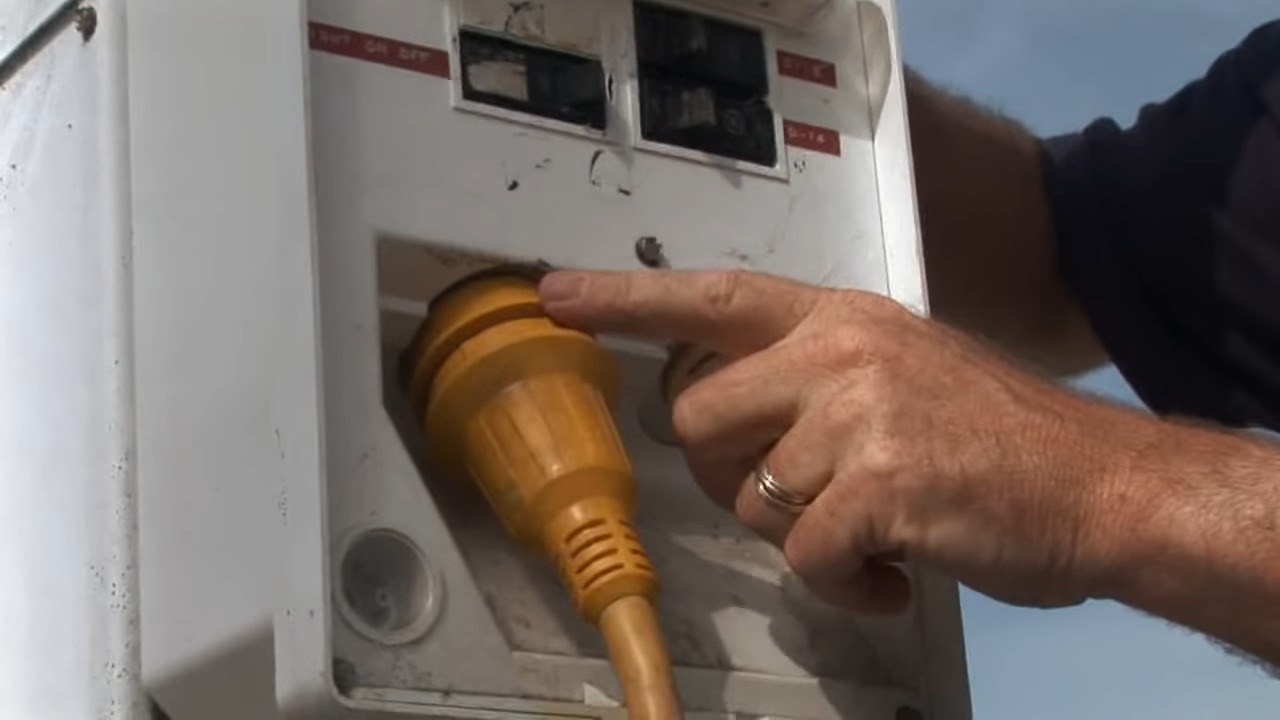
What are the benefits of using shore power?
There are many benefits to using shore power on a boat. Perhaps the most obvious is that it eliminates the need to run your boat’s engine, which can save wear and tear on the engine and reduce noise and pollution.
You can also use shore power to power onboard AC appliances, which can help you beat the heat or keep your food cold. Additionally, shore power can provide a reliable power source in an emergency.
Using shore power can also save you money on fuel costs. If you’re planning on staying in one place for an extended time, you can save a significant amount of money by using shore power instead of running your boat’s engine.
Additionally, shore power can help you avoid costly repairs by reducing the amount of wear and tear on your boat’s engine.
What are some things to remember when using shore power on a boat?
Shore power is a system that supplies electricity to a boat from an external source, typically a dock. Knowing how to use shore power on a boat to keep it running smoothly and avoid accidents is important.
There are a few things to keep in mind when using shore power:
– Make sure the shore power cord is the correct size and type for your boat.
– Inspect the shore power cord for any damage before using it.
– Connect the shore power cord to the shore power outlet on the boat.
– Once the shore power cord is connected, turn on the shore power switch on the boat.
– Test the shore power system by turning on a few lights or appliances on the boat.
– If you are not using shore power, be sure to disconnect the shore power cord and turn off the shore power switch on the boat.
What are the most common shore power problems?
A few common problems with shore power on a boat can occur. These include:
– Voltage drop: This can happen if the shore power cord is too long or if there is a problem with the shore power outlet.
– Current leakage: This can happen if there is a problem with the shore power cord or the shore power outlet.
– Power surges: This can happen if there is a problem with the shore power outlet or if there is a problem with the shore power cord.
To avoid these problems, it is essential to have a shore power cord that is the correct length and a shore power outlet that is in good working condition.
How can you prevent shore power problems?
Here are a few tips for using shore power on your boat:
– Always ensure that the shore power cord is correctly rated for the voltage and amperage your boat requires.
– Make sure that your dock has shore power compatible with your boat.
– Inspect the shore power cord for damage before each use.
– Use a surge protector to protect your boat’s electronics from power surges.
– Do not overload the shore power circuit.
– Make sure that your shore power outlet is properly grounded.
– Turn off all electronics and appliances on your boat before disconnecting from shore power.
Following these tips, you can safely use shore power on your boat and prevent shore power problems.
What are the risks of using shore power?
There are a few risks associated with using shore power on a boat. One is that the boat can be damaged if there is a power surge. Another is that the boat can catch fire if there are electrical problems. Finally, shore power can be expensive if the boat is not properly insulated.
What are the different types of shore power?
There are three types of shore power: AC power, DC power, and generators. AC power is the most common type of shore power and is what you’ll find at most marinas and docks. DC power is less common but is often used for smaller boats or in situations where AC power is unavailable. Generators are a more expensive option but can be a good investment if you plan to do a lot of boating.
Should you disconnect the boat battery when charging?
No, you should not disconnect the boat battery when charging. Connecting to shore power does not automatically mean that your batteries are disconnected from the system.
When plugged in at a dock or marina, the shore power charger will automatically connect to your boat’s battery bank and start charging. You should not disconnect the boat batteries when plugged in because it could cause a short circuit that damages the batteries.
The only time you should disconnect the house bank from the boat’s electrical system is when there are problems with your charging system or if you need to work on something that could be damaged by electricity.
Does shore power need to be GFCI protected?
The GFCI protection is not a requirement for shore power, but your boat’s electrical system might require it. If you’re in an area with frequent lightning strikes or if you have a sensitive electrical system, you may want to get GFCI protection.

- Type W Extension
- Type W Pigtails
- Type SC Extension
- Type SC Pigtails
- Type SC Turnaround
- Type SH Extension
- Extension Cords
- Spider Boxes Cables
- Welding Cable Extension
- Banded Sets
- Pin & Sleeve Extension
- Posi-Lok Adapters
- Stage Pin Extension
- 19 Pin Assemblies
- PowerCON Extension
- XLR Extensions
- Custom Cable Labels
- --- All Products ---
- Extreme Duty
- Accessories & Supplies
- Cam Lock Panel
- Cam Lock Connection Box
- Generator Connection Box
- Company Switches
- Cam Lock Connection Switches
- Quick Connect Switches
- Combiner Box
- Load Bank Docking Station
- Variable Frequency Drive
- Transfer Switches
- Inlet / Outlet Boxes
- Transformer Carts
- Portable Power Packages
- Custom Cable Printing
- Type DLO Cable
- Type DMX Cable
- Type SC Cable
- Type SH Cable
- Type SJOOW Cable
- Type SOOW Cable
- Type W Cable
- Type STOW Cable
- Mining Cable
- Datacomm Cable
- Fiber Optic Cable
- Other Accessories
- Panel Mount
- Mechanical Lugs
- Compression Lugs
- Pin & Sleeve Devices
- Connectors, Boxes, Plugs & Receptacles
- Mining Connectors
- Shore Power Adapters
- Wire & Cable Tools
- Compression Tools
- Generator Maintenance Kits
- Terminal Kits & Splice Kits
- Bulk Containers
- Floor Enclosures
- Wallmount Enclosures
- Fiber Optic Enclosures & Accessories
- Distribution and Control
- Clearance Sales
- Power Assemblies
- Schneider Electric
- Entertainment
- RVs and Trailers
- Cable Repair Program
- Medium Voltage Testing Program
- Resource Center
- Camlock Panel
- SWITCHGEAR PORTFOLIO
Marine Shore Power Basics: What You Need to Know
Marine vessels are often in need of an electrical power source to deliver a safe supply of power to all their tools and accessories on board - while docked at a port, shipyard, marina, or home. This is called Shore Power ; which is an external source of electrical power, commonly supplied by a power pedestal or portable generator , which provides alternating current (AC) to your vessel. It’s important to have accessible shore power at a marina to eliminate fuel consumption when docked for lengthy periods of time. You should never run your boat’s engine when staying overnight, but rather find access to a safe and secure shore power connection to operate the appliances on board.
Depending on the size of your boat, it will require a specific amperage to power the appliances on board such as the air conditioning, microwave, or 120V power outlets. For example, mid-size boats under 40 feet typically use a 30-amp, 125V shore power connection that can provide enough power to support almost all the equipment on board the vessel. In this situation, you may run into the issue where your air conditioning will require too much power, and you will not be able to operate some of your other accessories on board from this smaller, 30-amp connection. The next step up for larger boats that are over 40 feet is a 50-amp 125V/250V connection or 100-amp single phase or 100-amp 3 phase connections for yachts requiring a substantial amount of energy to stay fully connected.
Marine Shore Power Cable Assemblies

ATI has recently launched a marine sales division to assist our customers with anything and everything marine - with shore power being one of our specialties! We stock electrical cables and connectors from multiple highly respectable marine brands such as Hubbell , Leviton , Arrowhart/Eaton , Power Assemblies , and Marinco Power Products . It’s important that you only use shore power cables that are rated for marine grade use , which is why ATI stocks only the best. Give our team a call any time at (954)-644-3876, and we will be happy to help with all of your marine projects. No matter the application, ATI has got you covered. We stock bright yellow and black marine grade cable assemblies for all boat sizes with amperages ranging from 30A, to 50A, and even up to 100A single phase or three phases. ATI is proud to be your first-choice distributor for everything marine.
Custom cable assemblies and adapters are available directly on our website. Those of you who are constantly traveling to and from different marinas know how important it is to keep some marine adapters handy. Considering the fact that every marina is different, and they utilize different dockside outlets and inlets. Not all the power pedestals are the same, therefore depending on where you’re docked, you could be needing a completely different configuration to get your boat connected. Fortunately, ATI stays prepared for these situations, and provides marine adapters which you can find on our website, or just give us a call and we’ll get it ordered. Don’t hesitate to reach out to our experts regarding a shore power hookup – they have years of experience in the industry. Our sales reps are knowledgeable, friendly, and eager to help all our customers with any requests.
Ensuring you have a secure watertight connection is key to avoiding potential electrical shock hazards while on board your boat. You should never plug your boat into a regular outdoor extension cord with a standard straight-blade Edison connection , as they can easily pull apart and cause electrical current to leak into the surrounding water areas. All marine grade cables and shore power connections should have a twist-locking connection. If your shore power cables fall into the water while disconnected, you should immediately turn off the power from the circuit breaker, then spray down the contacts with water displacement spray, and dry off before turning the power back on. For this reason, it’s so important to be sure to always use shore power cables with waterproof boots.

Connecting Through Shore Power
While Shore Power is very common at most marinas or docks, the dock power pedestal can often be in use by other boats which can leave you without power. In this scenario, ATI often recommends keeping a portable power distribution box on board that contains multiple shore power outlets to distribute power to your boat. You can find a variety of different spider boxes on our website with multiple shore power configurations. You can also view our Spider box buyer’s guide on our site to help pick out the perfect portable distribution box for your application. To learn more about shore power connections and how you can stay powered at any dock or marina, watch our YouTube video below, and don’t forget to subscribe to our YouTube channel to see more videos like it in the future!
For any additional temporary power or shore power questions, please contact our portable power experts today at (954)-644-3876 or send us an email at [email protected] .
Leave a comment
Comments must be approved before appearing
* Required fields
Checkmark icon Added to your cart:
Yachting Monthly
- Digital edition

How to install shore power on a yacht
- Duncan Kent
- January 12, 2024
Marina AC power is safe and convenient, as long as you know how to install and manage it properly aboard your yacht. Duncan Kent offers expert advice
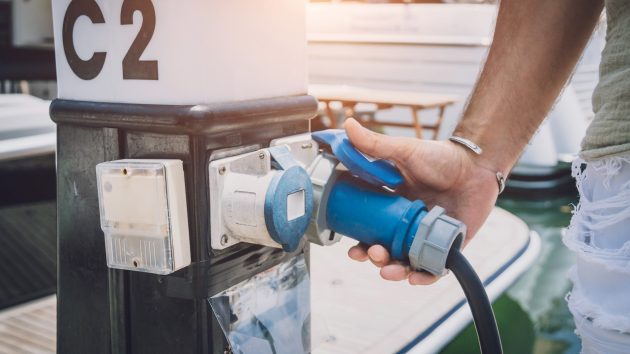
Not long ago, having any form of mains AC (alternating current) on board a small to medium sized leisure boat was rare. But now, having shore power in a yacht is increasingly standard practise.
A 240V facility seems to be a prerequisite of any marina berth, supplying enough power to run heaters, kettles, water heaters, microwaves and more. In fact, it’s becoming increasingly rare to find any boat relying on its own power resources whilst marina-based, even when they’re paying for it on a meter.
However, this new abundance of AC power comes with the problem of how to safely handle and manage it aboard a yacht. It’s important to remember that AC can be a killer, particularly when you’re floating on a highly efficient conductor such as salt water. It’s vital, therefore, that great care should be taken over an onboard AC installation, which, for many, will mean calling in professional assistance.

Shore power cables have become essential cruising kit
Any AC installation starts with the shore power cable, plugs and onboard sockets.
In UK marinas and boatyards, the connection points are now pretty much standardised so it’s possible to buy a kit with a pre-terminated cable and a suitable socket for the boat. Despite having a water-resistant gasket and sprung, waterproof cover, the boat socket should ideally be mounted in a relatively protected area.
Inside the boat, the current carrying capacity of the cable running between the shore power inlet socket and the consumer unit (CU) must be as high, or higher than the maximum supply current, and no more than 3m long. Although most UK pontoon outlets are limited to 16A, it’s advisable to install a 30A, 3-core cable to the CU.
Cable to match these ratings is readily available from most marine electrical suppliers, but it needs to be the flexible, multi-strand, and preferably tinned conductor type, not the solid copper conductor intended for domestic wiring. This is so the conductor will not fracture when subjected to vibration or flexing.

A galvanic isolator should be installed
Installing isolators
It is highly recommended you install a galvanic isolator (GI) into the earth circuit on the shore side of the CU, which will allow high voltage AC currents to be conducted to earth, but in the event of a problem will stop any DC leakage (up to 1.4V) from flowing.
An alternative to a GI is an isolation transformer, which is by far the best way to eliminate the risk of stray currents and other problems, as they effectively leave the boat totally isolated from the shore connection while still creating a 230V AC supply. However, isolation transformers are expensive, bulky and heavy, so are rarely fitted to small craft.
If the cable is to be fed through a cockpit locker or similarly vulnerable space it should run through protective trunking. Plastic mini trunking epoxied onto the hull side is very effective and allows you to add, inspect or remove cables easily later on.
It’s also important to be able to check and correct the polarity of the supply. Polarity detectors are easy to find; in fact some CUs or AC panels now incorporate them, but actually changing the polarity over to what it should be requires a switch or polarity reversal cable inserted into the shore power lead.
Some protection against polarity reversal is included if the correct CU is installed, as it will have double-pole circuit breakers to ensure that whichever conductor is live is always disconnected.

Signs of damage on an overheated shore power cable
Safety and circuit protection
A suitable consumer unit (CU) must be installed to provide protection against electric shock hazards. It must meet the latest regulations for mobile installations, which means you can’t just buy a domestic unit or one designed for sheds and garages.
By law, all AC installations must have a Residual Current Device (RCD), also known as a Ground Fault Circuit Interrupter (GFCI), as the first line of protection in any AC circuit. The correct RCD for mobile installations is an A-type, as opposed to the domestic AC-type, and it should also contain double-pole Mini Circuit Breakers (MCB), not the more common single-pole breakers.
An RCD is a two-pole circuit breaker used to protect circuits and people from current leakage to an earthed source. Under normal operation, the current flowing into the appliance via the live conductor should be identical to that returning via the neutral wire.
If it isn’t, then some of the current must be leaking out from the appliance via the earth wire, or through some other conductor (such as a human being), in which case the RCD will trip.
You should also fit a suitably rated MCB for the AC socket outlets, and separate dedicated MCBs for heavy load devices such as an electric cooker.
When planning the system, calculate the total AC current you’re ever likely to draw simultaneously (bearing in mind most shore power supplies are 16A), and the maximum load on each branch off the CU, in order to select the correctly rated circuit breakers. Remember, an MCB is there to protect the cable, not the appliance, which should have its own built-in fuse or trip.

An RCD will trip if an appliance is producing a natural earth leakage
Nuisance tripping
An RCD can trip for no apparent reason. This can either be caused by the system having two neutral-to-earth (MEN) links at different potentials (centre tapped inverters for instance), or some appliance that is producing a small amount of natural earth leakage.
Any AC power source, be it grid, generator or inverter, always has to have a MEN link. In the case of the grid, this is usually done at the sub-station, but it can be done additionally at a point of distribution such as a meter board.
With a generator, the link is pre-wired internally, and the same goes for many inverters. With inverter/charger combis, it’s more complex as the link is needed when inverting but not when charging, as that is provided by the grid or generator. So, combi inverters will usually have a relay that switches between the two.

A UK mains electric plug showing the correct wiring
Distribution and wiring
Mains 230V AC systems must have a separate switch panel to the DC wiring to avoid any risk of confusion or leakage across to the DC system. Some marine specific AC distribution panels have circuit protection built in, however, it’s important to ensure any circuit breakers supplied are double-pole and the trip-free type that cannot be held in the ‘on’ position in the event of it tripping out.
Regulations also state that the panel must be clearly marked with a ‘240V AC – risk of death’ warning sign, stating that the shore power cable should be disconnected before accessing the wiring. Furthermore, the panel must require a tool to access the wiring at the rear, and all the AC terminations should be protected by a screwed-down cover carrying an additional warning label.
AC cabling should ideally be kept separate from the DC wiring and not bundled together inside a conduit, although the regulations state this is acceptable provided the cables have a partition between them.
Keeping them separate is primarily for safety reasons, but also because the DC side might induce an additional current within the AC cable that can cause interference with sensitive electronic equipment.
Cables not inside conduit should be supported with cleats every 400mm, and clearly marked as AC conductors at regular intervals.
Normal domestic AC sockets may be used around the boat (provided they have an earth terminal), although it’s preferable to use the type with a sprung protective cover to avoid any splashes getting into the sockets.

Take care when connecting mains electricity in a marina – damp fingers can kill
Connections and terminations
As with DC wiring, how well the conductors are terminated dictates how efficiently and safely the whole AC system will operate.
Only ring terminals that correctly match the studs, or flanged spade connectors should be used as these will physically resist being pulled off. Ideally, use heat-seal terminals that have adhesive incorporated into the stem. Alternatively, if using standard crimp terminals, heat shrink should be placed around each joint and shrunk on tightly.
This not only seals the joint from moist air, but also provides additional strain relief on the wire.
It’s a good idea to use write-on identification heat shrink above the connector to indicate which wire does what. It is debatable whether it’s better to actually state what the wire does, or where it leads to, rather than using a numbering system whose index is highly likely to get lost at some point.
Article continues below…

The technical challenges of recycling batteries
Batteries are in many ways anathema to sailors. They are heavy, finicky things, whose performance wanes with time, requiring an…

Sail handling systems: push button sailing
Electric sail handling systems are not just for maxi yachts. Sam Fortescue looks at how push button sailing is filtering…
Nylon cable ties are cheap and much better for keeping cables together than insulating tape, which often goes gooey and unpeels over time. You can also get self-adhesive cable tie mounts to keep the wiring organised and tidy.
Use rubberised grommets when feeding cable through bulkheads and panel holes to protect the insulation. Alternatively, lengths of flexible grommet are available for trimming round large, or non-round apertures.
Finally, always allow enough cable at the back of the distribution panel in order to hinge it down or place it on a flat surface to work on.
Also, drip loops should be incorporated into any loom before it reaches the panel, consumer unit or any other electrical appliance.
It can’t be emphasised enough that AC (even the output of a small inverter) can kill someone who sticks damp fingers in the wrong place, so a clear distinction between AC and DC outlets must be made and the appropriate label applied.

Connections inside a typical 10kVA 230V transfer switch
Multiple AC sources
In cases where there is more than one source of AC (grid, generator and/or inverter), never allowing more than one source to be applied to the same circuit simultaneously is of critical importance. Different supplies should always be fed directly into a manual or automatic multi-way transfer switch that can totally isolate the different sources from each other. Connecting two or more differently phased AC supplies together is likely to cause a serious fire.
Automatic relay-switched control boxes are available that can disconnect one supply (inverter, say) when it detects another (the grid maybe) is present, but if you are in any doubt about how to interconnect more than one supply, you are seriously advised to seek advice from a professional electrician.
Tips to install shore power on a yacht
- Buy the right capacity and type of cable for each job
- Keep the cable from inlet to RCD as short as possible (max 3m)
- Segregate all AC wiring from the DC and install separate switch panels
- Clearly mark all AC devices and cables with warning labels
- Protect and support cables in open areas or engine compartments
- Fit an overload circuit breaker for each high-current device
- Fit a polarity reversal indicator and changeover switch
- Connect any device to the incoming supply (other than a GI) before the RCD
- Use cheap terminal blocks as connectors
- Install AC cables in the bilges
- Use solder on any cable terminals
Enjoyed reading this?
A subscription to Yachting Monthly magazine costs around 40% less than the cover price .
Print and digital editions are available through Magazines Direct – where you can also find the latest deals .
YM is packed with information to help you get the most from your time on the water.
- Take your seamanship to the next level with tips, advice and skills from our experts
- Impartial in-depth reviews of the latest yachts and equipment
- Cruising guides to help you reach those dream destinations
Follow us on Facebook , Twitter and Instagram.
Search form
Marine battery and power management basics.
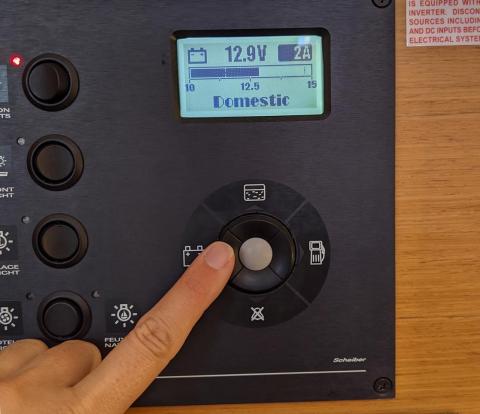
One of the most common causes for a marine engine's failure to start is also one of the simplest to prevent. Monitoring your power consumption while away from shore ensures your batteries will be charged enough to start the engine when you're ready to weigh anchor or douse the sails and motor in. These basic power management tips will help you keep your batteries healthy - and avoid a tow back to the docks.
Upon Arrival
- All Modern Sailing yachts have two or more batteries. At least one battery is dedicated to starting the engine, the other(s) powers the house electrics.
Catalina 320 circuit breaker panel and battery switch.jpg
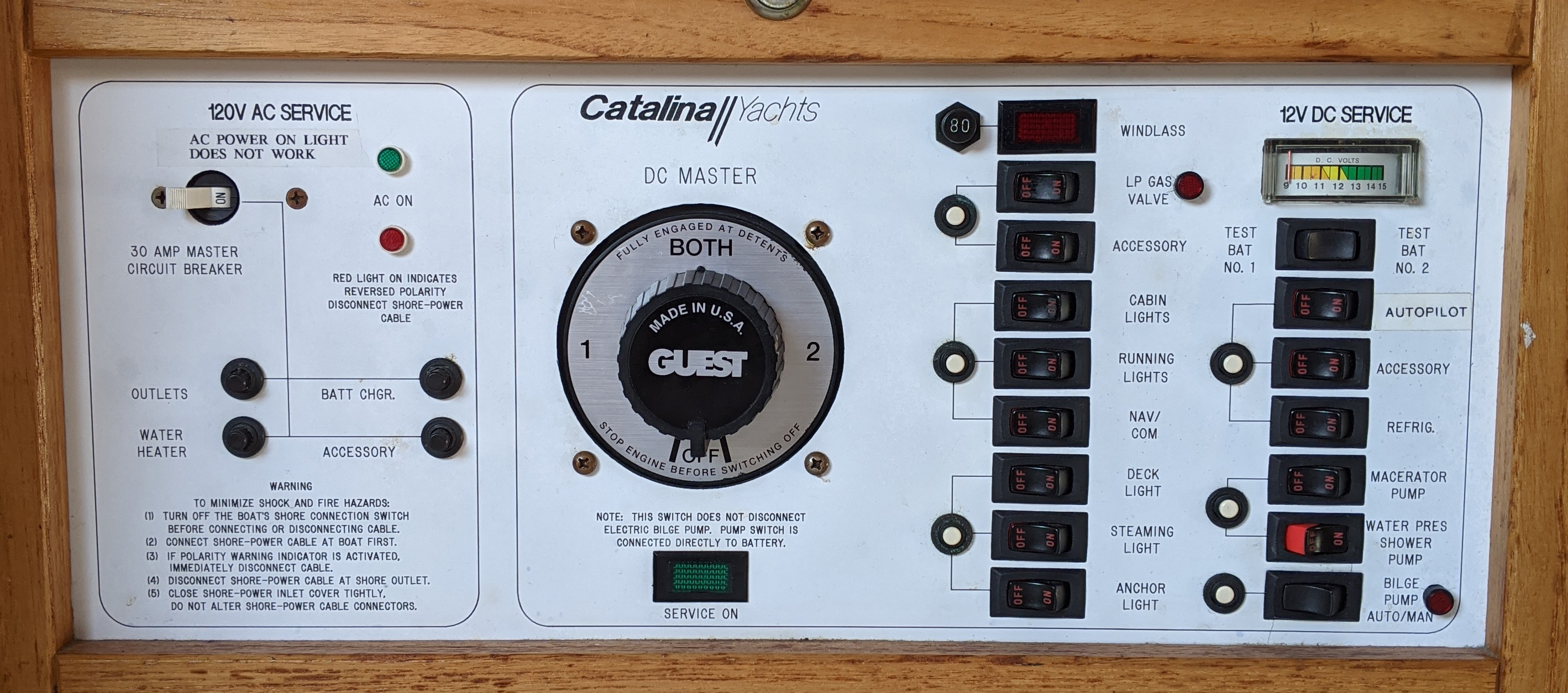
Beneteau battery switches.jpg
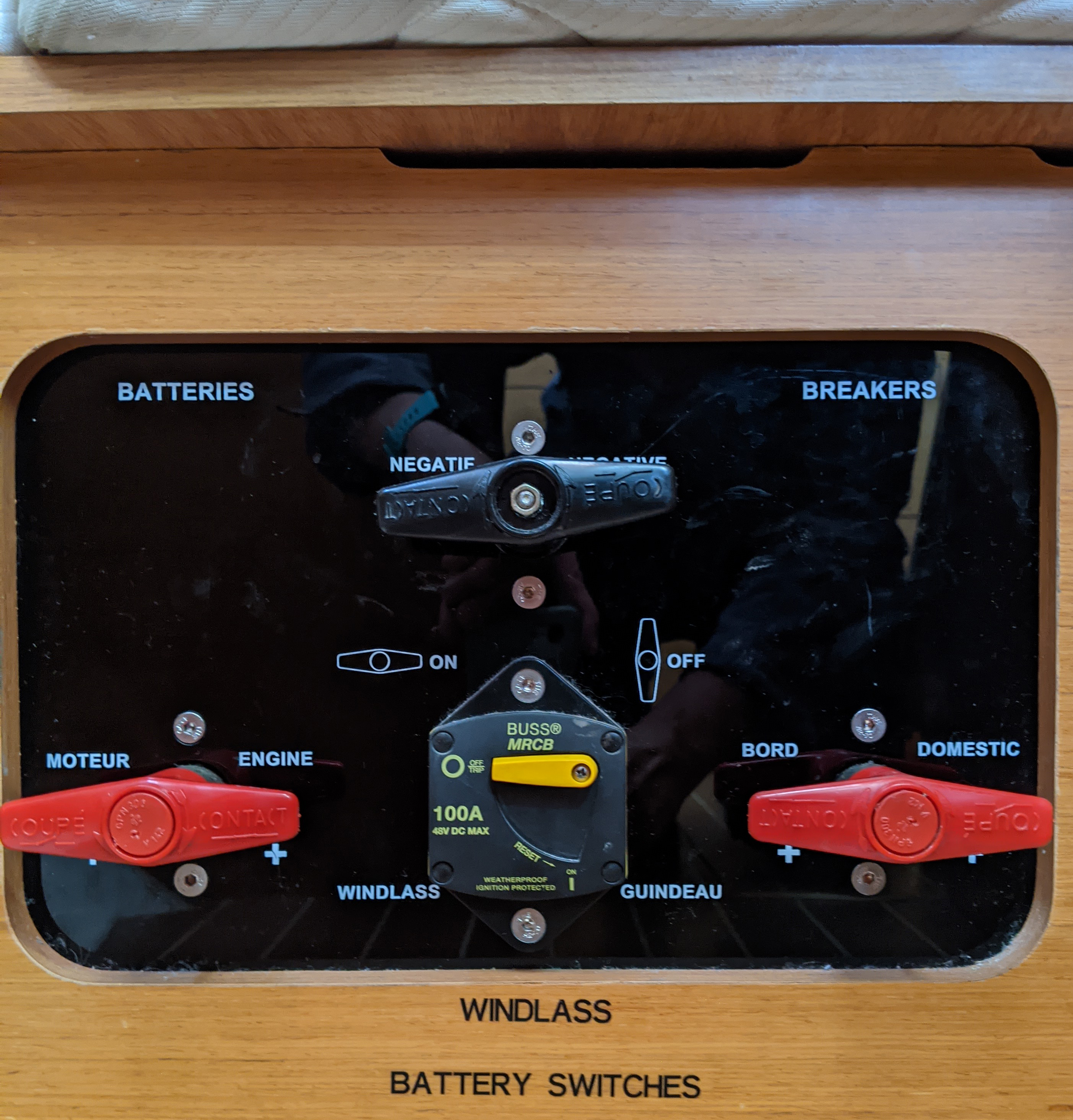
Starting the Engine
- At the dock box's shower power outlet, turn the breaker switch off before starting your boat's engine. This will enable you to verify that your engine will start independently of shore power.
Beneteau battery monitor.jpg
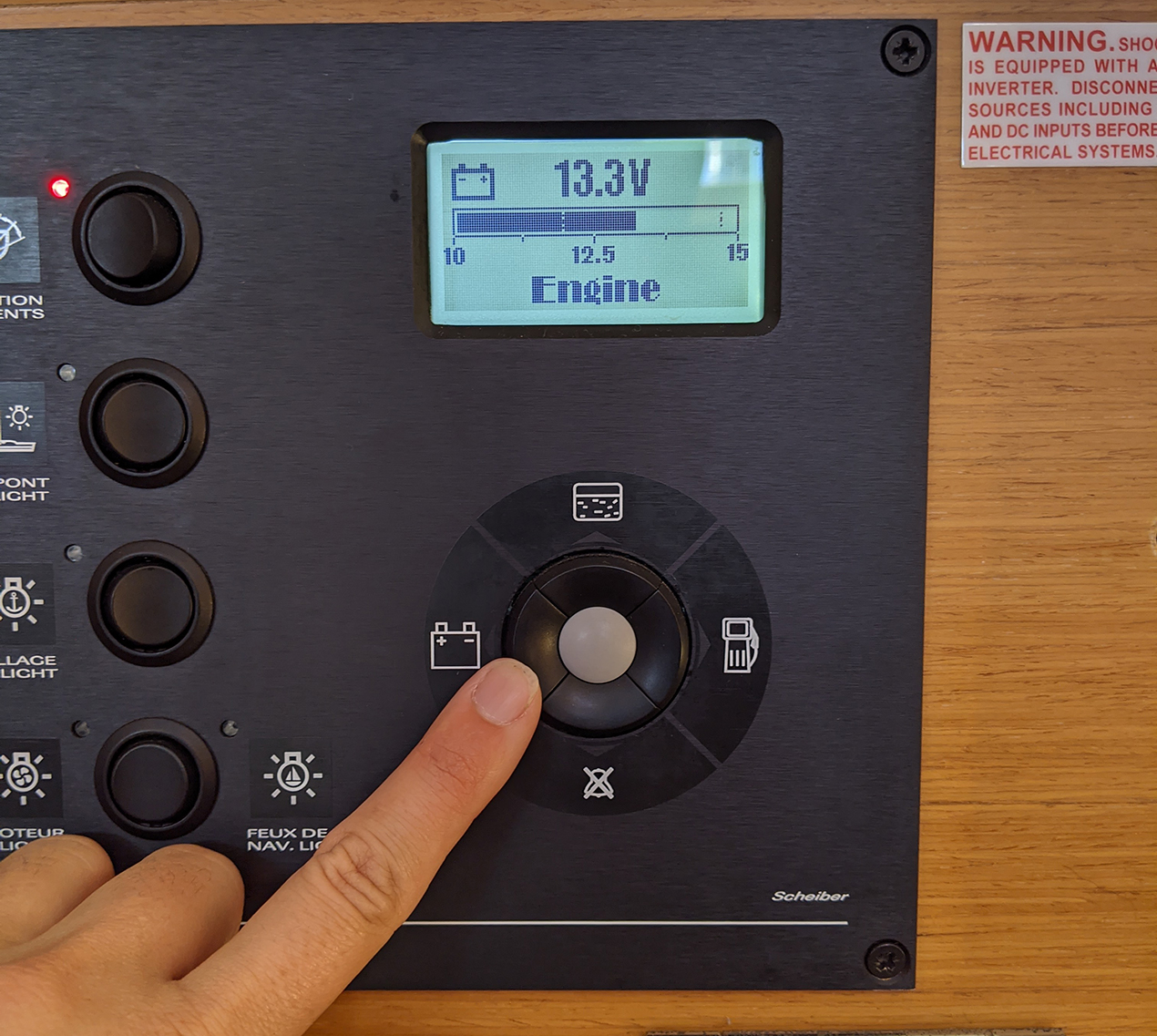
Catalina 320 battery test.jpg
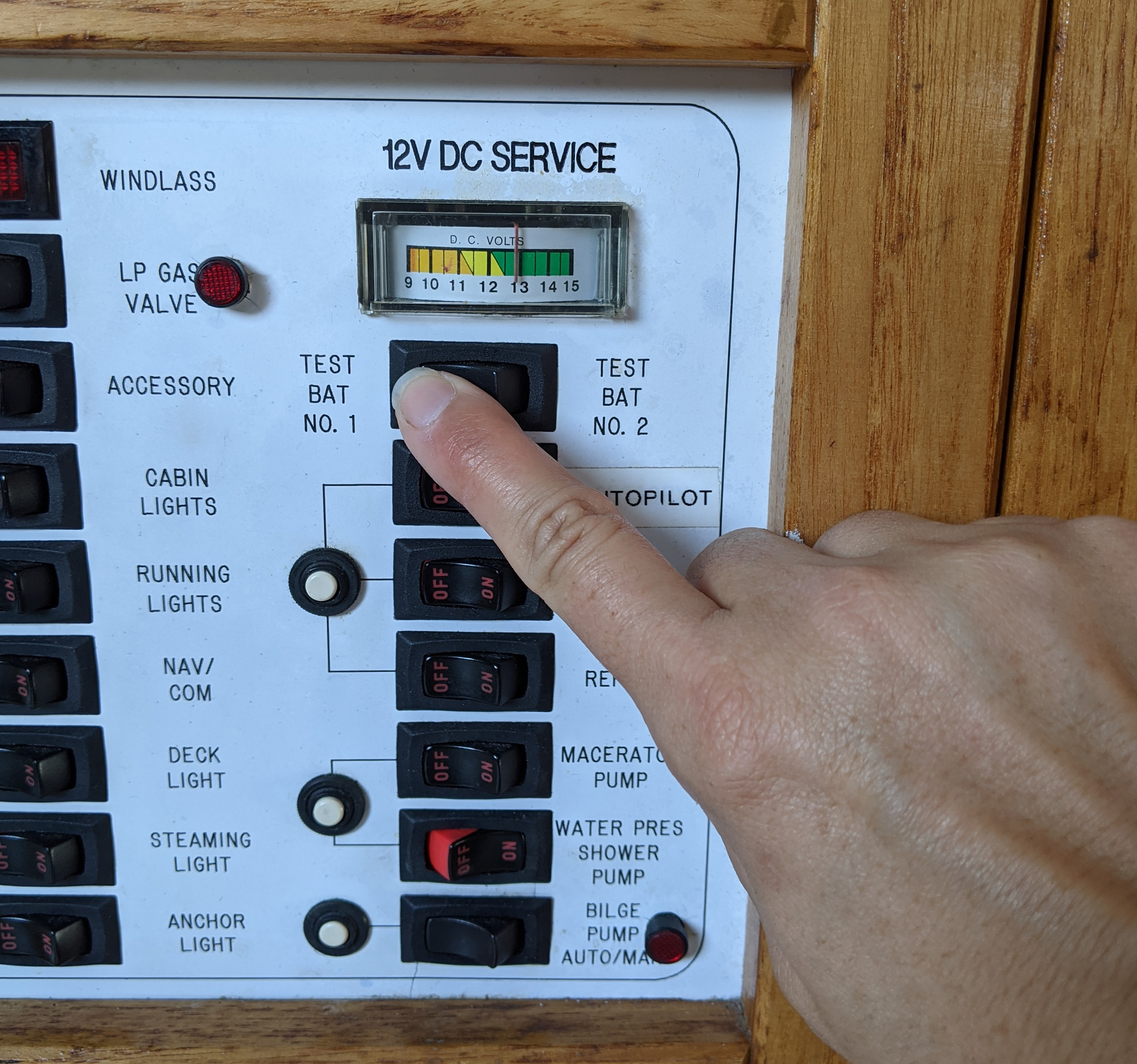
battery monitor 2.jpg
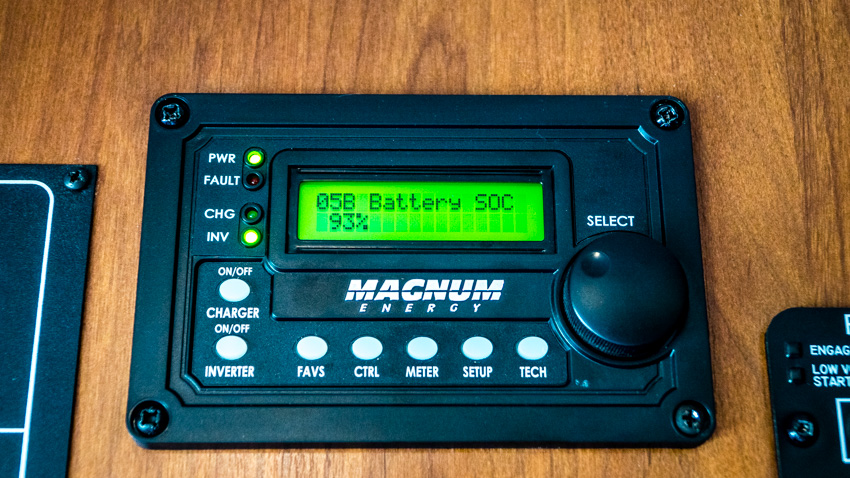
- Start the engine. You'll find instructions in your Boat Check-Out Form's "Unique Aspects of the Boat" section and also in your boat's white binder.
- When you're ready to go, unplug the shore power cord from the vessel and coil it tightly around the dock box. Ensure no part of the cord (especially the plug/connector) is at risk of dangling in the water. You may take the shore power cord with you if you plan to dock overnight at a different location.
- IMPORTANT: Discuss the importance of electricity conservation with your crew.
While Sailing or at Anchor
- On most MSC boats, leave the battery switches turned to ALL, BOTH, or in the horizontal position. On the Catalina 30s, turn the battery switch to OFF unless you need to turn on the navigation lights or start the engine.
- Leave the switch labelled Battery Charger, A/C Main, or A/C Master ON. With this switch off, your batteries will not charge.
- If your boat is equipped with a refrigerator/freezer, switch it off at the circuit breaker panel to conserve power. It is recommended to leave it off whenever you are away from shore power.
- Do not attempt to use high-wattage appliances such as a microwave or a hair dryer while disconnected from shore power. If your boat is equipped with an inverter, you can use the microwave, but monitor your battery status closely. Learn more about onboard power and inverters in our article Onboard Electricity Basics .
- IMPORTANT : When operating the windlass, the engine MUST be running, otherwise the batteries will be drained very quickly.
Monitoring Battery Status
During your sail or while at anchor, periodically take a look at the battery monitor to check on the status of the batteries.
- 12.7 volts or more represents a fully charged battery.
- When the voltage meter displays around 12.4 – 12.3 volts, run the engine for a bit to charge up the battery.
- IMPORTANT : Do not let your battery charge drop below 50% (12.2 – 12.3 volts).
Returning to Dock
Following these steps will ensure that the batteries will be fully charged up for the next charterer.
Two crew members, one on deck and one on the dock, will work together to reconnect the shore power cable, taking great care to ensure that neither end of the cord falls into the water. (Saltwater is highly corrosive and will quickly - and permanently - damage a shore power cable.)
- Run the shore power cord through the bow pulpit.
- With the crew member on the dock feeding out the cord to the sailor on deck, walk the shore power cord to the back of the boat.
- Wrap the cord once or twice around the stern pulpit or lifeline, then connect the female end of the cord to the boat’s shore power receptacle.
Shore power cord wrapped around dockline.JPG
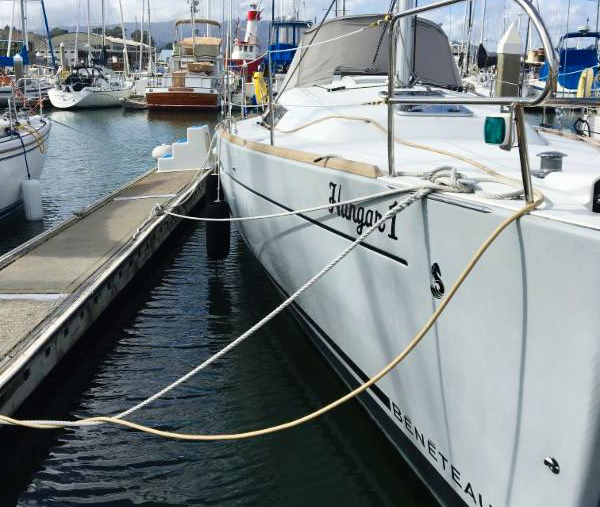
shore power plug LED.jpg
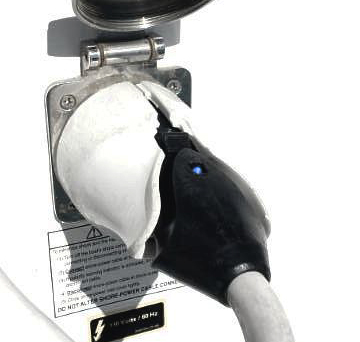
- IMPORTANT : Again, please leave the switch labelled Battery Charger, A/C Main, or A/C Master ON to ensure that the batteries will charge.
- Also, leave the automatic bilge pump switch ON.
- Switch the batteries to the “OFF” position.
Questions about onboard power management? Learn more by taking ASA courses 101 - 103. ASA 104, Bareboat Cruising covers this topic in detail. As a Modern Sailing member, you may also ask questions of our instructors when you arrive for your charter.
By Mary Elkins on October 22, 2020
Share This Page
Testimonials.
The Full Moon Sail with Skipper Bob Gutsgell was Ah-Mayzing!! The group dynamic was lovely and the views spectacular. I can't say enough good things about the experience. Thanks so much for the wonderful Club Sails , they are really great.
The class was terrific. I know you must get many compliments about your sailing instructors...But I must tell you that Robert is outstanding. Having taught SCUBA, I really appreciate the way he is so sensitive to all on board, dealing with each so well, knowing quickly their strengths and weaknesses making each feel special and cared for.
Here are some snaps of Our Saturday, August 20, 2022 Modern Sailing Expedition with Captain Robert Bivin, who was outstanding. Please convey photos and thanks to him. He is an outstanding individual, leader and sailing instructor. His knowledge and experience made us all feel safe and our Farallones Day Trip educational and just amazing.
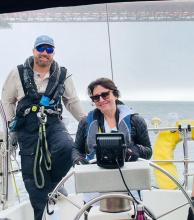
View All Testimonials
Follow us on Social Media

Modern Sailing School & Club
Sausalito Location 2310 Marinship Way, Sausalito, CA 94965 (415) 331-8250 (800) 995-1668
Berkeley Location 1 Spinnaker Way, Berkeley, CA 94710 (415) 331-8250 (800) 995-1668
Map / Directions
You are here.

- Forums New posts Unanswered threads Register Top Posts Email
- What's new New posts New Posts (legacy) Latest activity New media
- Media New media New comments
- Boat Info Downloads Weekly Quiz Topic FAQ 10000boatnames.com
- Classifieds Sell Your Boat Used Gear for Sale
- Parts General Marine Parts Hunter Beneteau Catalina MacGregor Oday
- Help Terms of Use Monday Mail Subscribe Monday Mail Unsubscribe
Installing shore power
- Thread starter Erbardy
- Start date Feb 17, 2022
- Forums for All Owners
- Ask All Sailors
Erbardy said: I am making sure a ground goes to my lightening rod ground Click to expand
jssailem said: Can you expand on this connection? How is this ground associated with your work on your Shore Power connection? Click to expand
Stu Jackson
1. Please learn how to spell. 2. Pictures of wiring with questions about it without a wiring diagram are useless. Makes it impossible to help or to answer your question.
Way back when you first started this project, I and others suggested that boat wiring is different from house wiring. You seem to not heeded that suggestion. In the first photo there are wire nuts sitting on the counter. Wire nuts have no place on a boat. This can cause your boat to catch fire. Without seeing the actual connections and a schematic no one can provide any helpful advice, beyond finding someone who understands marine wiring to help you.
Stu Jackson said: 1. Please learn how to spell. Click to expand
AC grounding in a boat is "free floating" and only grounds to shore. Grounding to the bonding system is not advisable.
Davidasailor26
Benny17441 said: AC grounding in a boat is "free floating" and only grounds to shore. Grounding to the bonding system is not advisable. Click to expand
dlochner said: Way back when you first started this project, I and others suggested that boat wiring is different from house wiring. You seem to not heeded that suggestion. In the first photo there are wire nuts sitting on the counter. Wire nuts have no place on a boat. This can cause your boat to catch fire. Without seeing the actual connections and a schematic no one can provide any helpful advice, beyond finding someone who understands marine wiring to help you. Click to expand
Stu Jackson said: 1. Please learn how to spell. 2. Pictures of wiring with questions about it without a wiring diagram are useless. Makes it impossible to help or to answer your question. Click to expand
The additional information helps. The reason stranded wire is used on boat is that it less prone to work hardening from vibration and movement. The stranded wire you bought at ACE is THN wire, AWG marine wire has more and thinner strands making it more flexible and less resistant to work hardening. Marine grade wire is also tinned which helps to prevent corrosion of the wire especially inside the insulation. While less of an issue in fresh water, moisture will intrude into the wire, unless the ends are properly crimped and sealed with heat shrink terminals. Are you using an ELCI? This is perhaps the most important part as it will prevent current from leaking into the water.
dlochner said: The additional information helps. The reason stranded wire is used on boat is that it less prone to work hardening from vibration and movement. The stranded wire you bought at ACE is THN wire, AWG marine wire has more and thinner strands making it more flexible and less resistant to work hardening. Marine grade wire is also tinned which helps to prevent corrosion of the wire especially inside the insulation. While less of an issue in fresh water, moisture will intrude into the wire, unless the ends are properly crimped and sealed with heat shrink terminals. Are you using an ELCI? This is perhaps the most important part as it will prevent current from leaking into the water. Click to expand
Erbardy said: I am using gfci water resistant recepticals if that is what you mean. Click to expand
jssailem said: Dave is discussing at your panel. The current panel design is to use an ELCI breaker on the incoming line. It serves to protect the system at the main entry point. The concern I raised, is you stated "a ground goes to my lightening rod ground." THIS IS NOT CORRECT. The lightening system is one that shunts a strike from the mast to the water and a "ground Plate" attached to the side of the boat. " Boats with internal ballast should have a copper ground plate of at least one square foot in size installed externally on the hull bottom." Here is a discussion of the ABYC info Lightning Protection - ABYC Recommendations and a simply image of connections. View attachment 202728 This is more complex and you should review the ABYC specifications "Standard E4 or consult a qualified marine electrician concerning your boat. Click to expand
Looks like a nice one. Size matters Hope it fits.
- This site uses cookies to help personalise content, tailor your experience and to keep you logged in if you register. By continuing to use this site, you are consenting to our use of cookies. Accept Learn more…
Marine Electric Systems is currently scheduling projects for 2024. Winter is a great time to upgrade to lithium batteries, update those outdated electronics or complete that project you have been putting off. Learn More

Understanding Shore Power
January 6, 2023
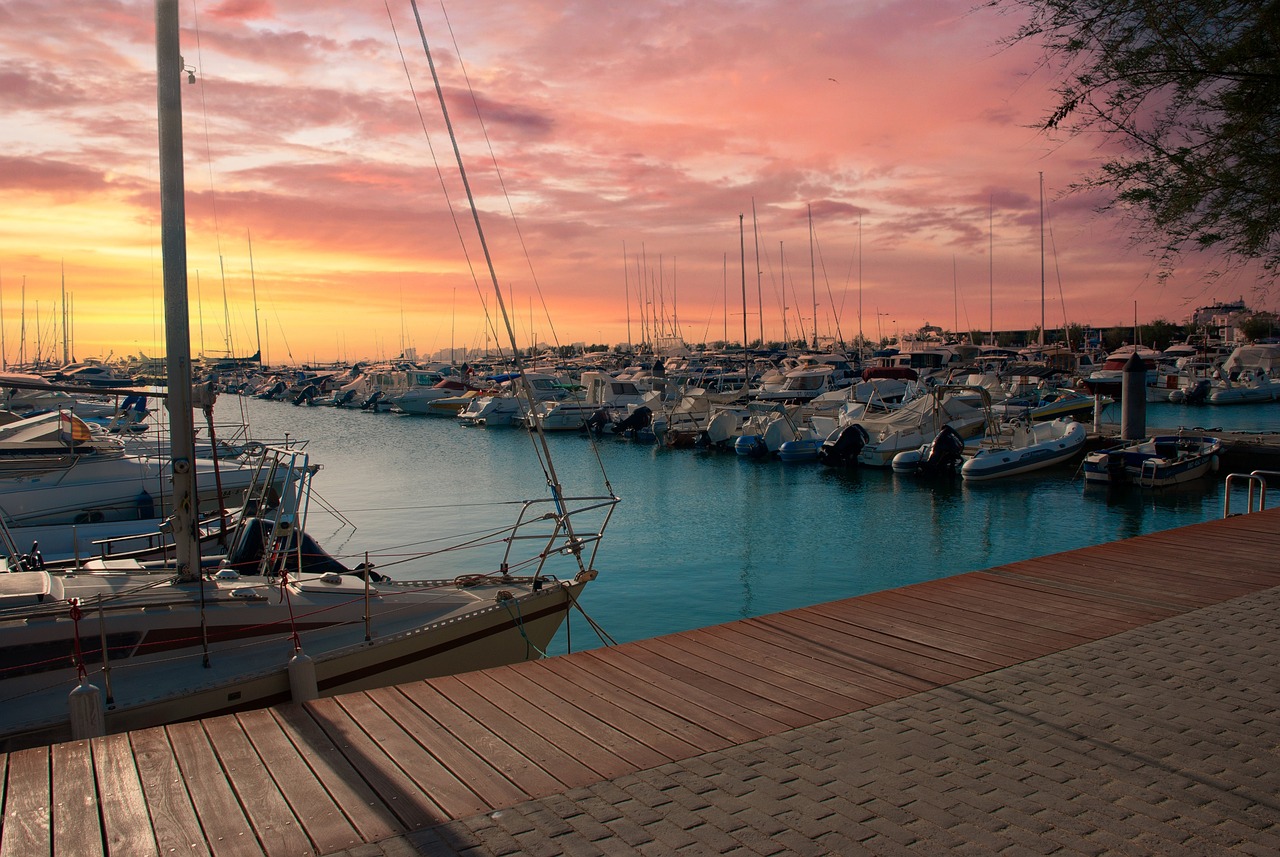
Never run your boat’s engine when staying overnight; instead, find access to safe and secure shore power.
Marine vessels need an electrical power source to deliver a safe power supply to all tools and accessories on board – while docked at a port or marina. This is called shore power, an external source of electricity that provides alternating current to your vessel. It’s essential to have accessible shore power at a marina to reduce fuel consumption when docked for lengthy periods. Never run your boat’s engine when staying overnight; instead, find access to a safe and secure shore power connection to operate the appliances on board.
What is Shore Power?
Shore power refers to the systems and components–ashore and on board–that provide alternating current (AC) electricity to a boat. This system generally consists of an onboard inlet and an AC breaker panel to protect circuits and distribute electricity to various electronic accessories. Though it is more technical, the setup is similar to the one in your home: there’s a supply, a breaker panel, and branches of wires that supply certain appliances and outlets.
How to Use Shore Power
As mentioned, you do not want to run your boat’s diesel engine while docked simply to power a microwave or to charge your phone. It would be a waste of power , so shore power is the ideal method for running A/C accessories. Most boats have a switch marked ‘shore power’ in the cabin. You connect your boat to a shore-side power source, usually a power pedestal to operate it. There is also a circuit breaker – which you will need to turn on when you are ready to use the power and should always turn off before unplugging your cable.
Safety Considerations When Using Shore Power
Shore power can potentially be hazardous if your cord or inlet fails due to improper maintenance. So you must use proper safety precautions when connecting or disconnecting from shore power. When you disconnect your cable from the boat, examine the end of the cord and the inlet. If there is any discoloration or evidence of melting around the plug’s blades or the inlet’s slots, you must replace the damaged portion before plugging back in. You should also regularly check the blades of your plug for any signs of corrosion. Blade corrosion can easily cause poor electrical connections, leading to overheating or fire.
If you accidentally drop your cord in the salt water, immediately turn off the breaker at the power pedestal, disconnect the plugs and rinse everything with fresh water. Dry it off and give it several days to ensure it’s completely dry before using it again.
Marine Electric Systems, LLC is a Leader In the Maritime Industry
We here at Marine Electric Systems have over 30 years of industry experience. You can trust our team for reliable service and expert craftsmanship in the Maryland, Baltimore, Annapolis, and Baltimore city areas! We’re highly certified and adhere to all ABYC and NMEA regulations. We specialize in top-notch electrical solutions for recreational, commercial, and government boating clients. Anything from electrical refits , to navigation system s, or boating maintenance . To stay up to date on our services, follow us on Facebook , LinkedIn , Pinterest , Instagram , and YouTube . You can also contact us at 410-263-0807 .
Categories: Boat Basics | Tags: electric systems , marine shore power , and shore power This entry was posted on Friday, January 6th, 2023 at 9:45 am. You can follow any responses to this entry through the RSS 2.0 feed. You can leave a response , or trackback from your own site.
- © 2024 Marine Electric Systems
- All Rights Reserved
- Website Design & Marketing provided by Adventure Web Interactive
- New Sailboats
- Sailboats 21-30ft
- Sailboats 31-35ft
- Sailboats 36-40ft
- Sailboats Over 40ft
- Sailboats Under 21feet
- used_sailboats
- Apps and Computer Programs
- Communications
- Fishfinders
- Handheld Electronics
- Plotters MFDS Rradar
- Wind, Speed & Depth Instruments
- Anchoring Mooring
- Running Rigging
- Sails Canvas
- Standing Rigging
- Diesel Engines
- Off Grid Energy
- Cleaning Waxing
- DIY Projects
- Repair, Tools & Materials
- Spare Parts
- Tools & Gadgets
- Cabin Comfort
- Ventilation
- Footwear Apparel
- Foul Weather Gear
- Mailport & PS Advisor
- Inside Practical Sailor Blog
- Activate My Web Access
- Reset Password
- Customer Service

- Free Newsletter

Tartan 30: An Affordable Classic

Ericson 34-2 Finds Sweet Spot


How to Sell Your Boat

Cal 2-46: A Venerable Lapworth Design Brought Up to Date

Solar Panels: Go Rigid If You have the Space…

Leaping Into Lithium

The Importance of Sea State in Weather Planning

Do-it-yourself Electrical System Survey and Inspection

When Should We Retire Dyneema Stays and Running Rigging?

Rethinking MOB Prevention

Top-notch Wind Indicators

The Everlasting Multihull Trampoline

Taking Care of Your 12-Volt Lead-Acid Battery Bank

Hassle-free Pumpouts

What Your Boat and the Baltimore Super Container Ship May Have…

Check Your Shorepower System for Hidden Dangers

Waste Not is the Rule. But How Do We Get There?

How to Handle the Head

The Day Sailor’s First-Aid Kit

Choosing and Securing Seat Cushions

Cockpit Drains on Race Boats

Re-sealing the Seams on Waterproof Fabrics

Safer Sailing: Add Leg Loops to Your Harness

Waxing and Polishing Your Boat

Reducing Engine Room Noise

Tricks and Tips to Forming Do-it-yourself Rigging Terminals

Marine Toilet Maintenance Tips

Learning to Live with Plastic Boat Bits
- Boat Maintenance
- Systems & Propulsion
- Safety & Seamanship
A cautionary tale of corrosion, fatigue, excess resistance, heat buildup, and finally...fire.
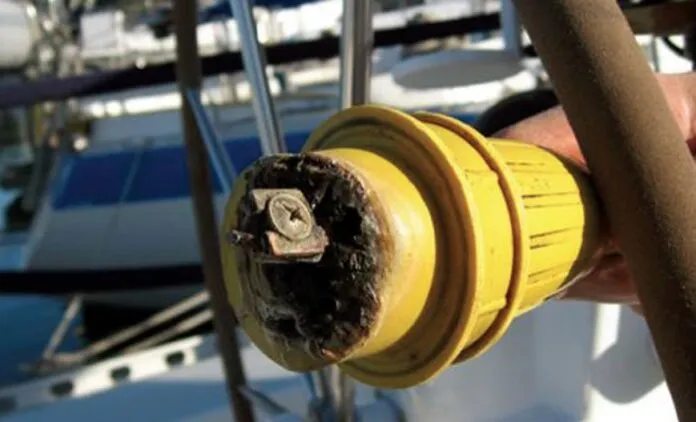
One of the often overlooked maintenance items in the pre-season rush to the water is the AC shorepower system. Over the years of surveying, I’ve amassed a small collection of scary photos from past surveys showing the common examples of neglect to this critical system.
Barring improper use or some owner fabricated MacGyverism gone bad (jury-rigged adaptors, botched plug installations, etc.) overheating and corrosion are the primary causes of AC shore power cord problems. Charred plugs and receptacles are the most common and are a result of resistance build up due to loose or corroded connections, which in turn generate heat and the potential for fire. The problem is especially prevalent among boats that continually run high energy loads such as water heaters and air conditioning units.
Basic inspections of your AC shore power system are easily accomplished and are well within the ability of any boater. The first step is securing all AC power to avoid accidental shock hazards. Turn off your boats main AC breaker, then the shore pedestal breaker. Next unplug the shore power cord and verify that all other sources of power (such as power on-demand generators and DC to AC inverters) are turned off and their respective breakers secured in the off position.
Start your inspection with the shore power cord itself, ensuring its constructed of proper marine grade components, uses appropriately sized wiring, and is the shortest cord that will get the job done. Always replace cords that show signs of chafe, cracks, split insulation, or those having electrical tape repairs.
Industry standards call for shore cords to have molded-on plugs with sealing flanges or appropriate weatherproof boots. The plugs themselves should be checked each time you disconnect shore power (prior to getting underway for example) or monthly at a minimum, particularly for discoloration or corrosion on or around pins and plug inlets.
By the time discoloration is visible at the front of a plug or inlet, you’ll typically find that the damage is greater upon opening up the back for inspection. If left uncorrected, the damage will snowball (due to increasing resistance and heat buildup) until it burns a hole through the face of the plug, possibly leading to a fire.
When inspecting your shore power cord its also crucial to check the dock pedestal outlet and your boats inlet receptacle, ensuring both are corrosion free and undamaged. Upon finding a charred power cord plug, many owners simply replace it or the cord itself, only to find the new one shorts out due to a burned dock receptacle or inlet.
Another good practice is checking the feel of the connection when plugging in. Those that feel loose or don’t seem to be making firm mechanical contact likely won’t provide good electrical contact either. Avoid using worn or damaged pedestal plugs and report them to marina personal as soon as possible.
Practical Sailor has looked at a variety of smart plugs that warn owners of problems. These include the SmartPlug ( PS , June 2010 ), which watches for shorts, and the West Marine GalvanAlert ( PS , October 2009 ), which checks for wiring defects and reverse polarity. For more on AC safety, see our five-volume eBook series Marine Electrical Systems, found at www.practical-sailor.com/books .
RELATED ARTICLES MORE FROM AUTHOR
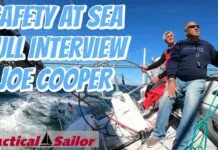
Safety At Sea Full Interview With Joe Cooper
This is an excellent article. Twice I have discovered burned plugs on the boat receptacle. I determined that this is the result of crew stepping on the plug and stressing the connection. The repair required replacing both the shore power cord and the receptacle. The location of the receptacle is poorly positioned near the boarding gate on my Island Packet 35. In both instances I was using the new EEL connectors. I like them a lot but do not feel they provide the same connection strength as the typical screw in collar. I plan on building a step cover over the connection to prevent this from happening, as well as regular inspections as the author recommends.
Excellent article. Marina operators also need to inspect their pedestals on a regular basis – I have seen a number of these (in various marinas in several states) where the outlets were in very poor condition.
LEAVE A REPLY Cancel reply
Log in to leave a comment
Latest Videos
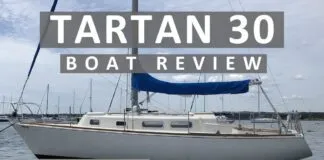
Tartan 30 | Boat Review

Fuel Contamination? The Baltimore Francis Key Bridge Collapse

Safety At Sea For You & Your Family – The Joe...

What’s The Best Vinyl Window Cleaner for Your Boat?
- Privacy Policy
- Do Not Sell My Personal Information
- Online Account Activation
- Privacy Manager

Service Locator
- Angler Endorsement
- Boat Towing Coverage
- Mechanical Breakdown
- Insurance Requirements in Mexico
- Agreed Hull Value
- Actual Cash Value
- Liability Only
- Insurance Payment Options
- Claims Information
- Towing Service Agreement
- Membership Plans
- Boat Show Tickets
- BoatUS Boats For Sale
- Membership Payment Options
- Consumer Affairs
- Boat Documentation Requirements
- Installation Instructions
- Shipping & Handling Information
- Contact Boat Lettering
- End User Agreement
- Frequently Asked Questions
- Vessel Documentation
- BoatUS Foundation
- Government Affairs
- Powercruisers
- Buying & Selling Advice
- Maintenance
- Tow Vehicles
- Make & Create
- Makeovers & Refitting
- Accessories
- Electronics
- Skills, Tips, Tools
- Spring Preparation
- Winterization
- Boaters’ Rights
- Environment & Clean Water
- Boat Safety
- Navigational Hazards
- Personal Safety
- Batteries & Onboard Power
- Motors, Engines, Propulsion
- Best Day on the Water
- Books & Movies
- Communication & Etiquette
- Contests & Sweepstakes
- Colleges & Tech Schools
- Food, Drink, Entertainment
- New To Boating
- Travel & Destinations
- Watersports
- Anchors & Anchoring
- Boat Handling
- ← Install & Repair
Safe Shorepower
Advertisement
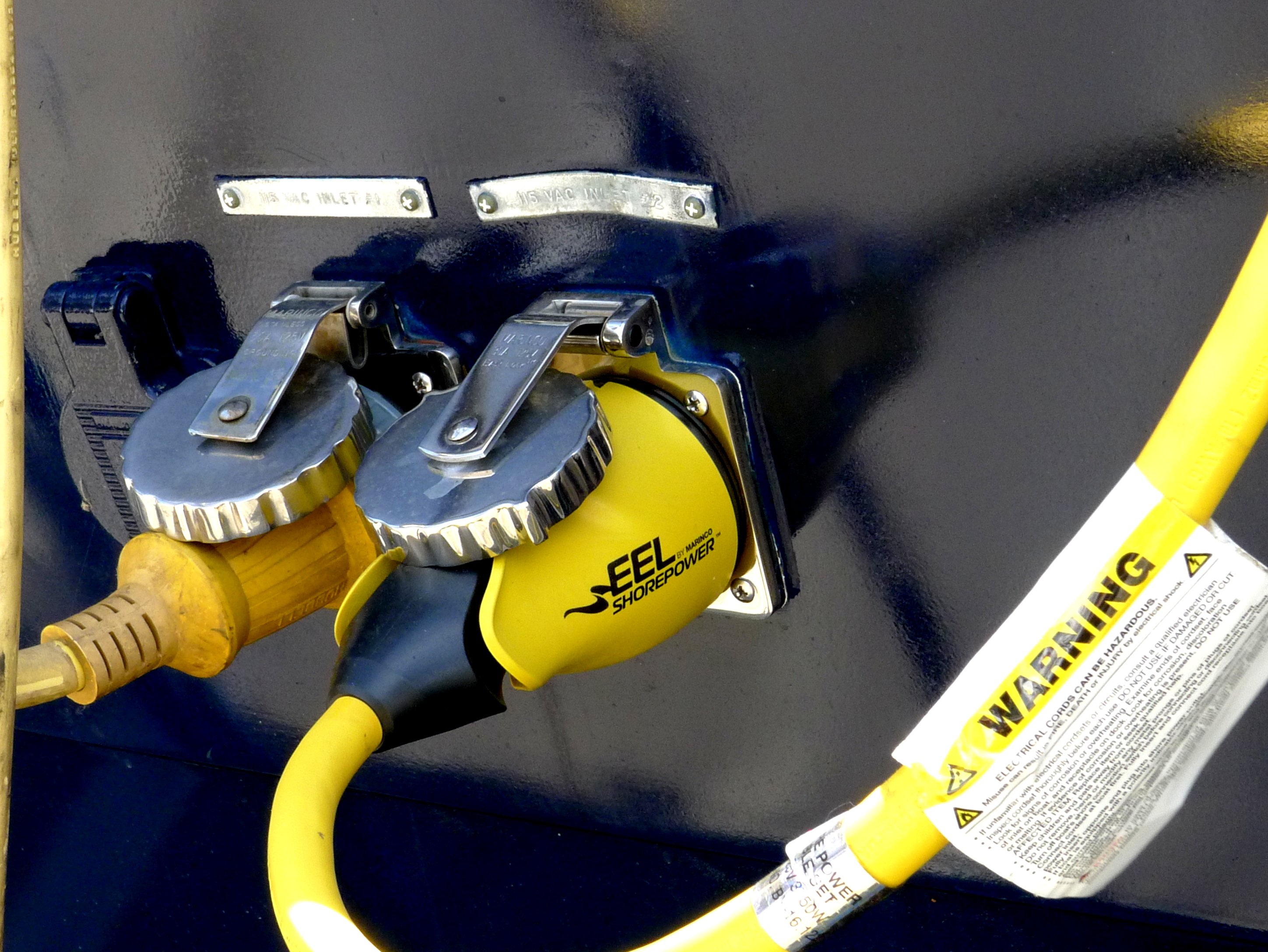
However you bring shorepower aboard your boat, if you do it without the appropriate safeguards, you place yourself, your crew, and your guests at a terrible — and foolish — risk.
Three-Conductor System
AC circuits use three wires, and it is essential to your safety to understand the function of each. Because the direction of current flow in an AC circuit is reversing 120 times per second (60 positive-to-negative-and-back-to-positive cycles), it is counter-intuitive to refer to one side of an AC circuit as positive and the other as negative. Instead, we call one side hot, the other side neutral. By code the hot wire in an AC circuit is black, red, or blue; the neutral wire is always white. Since the neutral side is connected to ground, it is the hot side of the circuit that is the most dangerous. However, you should always treat both sides with equal respect because a wire reversal to the outlet will make the neutral side hot.
The grounding wire changes all that. A short to the case instantly becomes a short to ground, probably opening the breaker in the circuit. Even if the short is insufficient to kick the breaker, or if it occurs while you are holding the appliance, the grounding wire still protects you by providing a lower-resistance path to ground than your body offers. Anything that degrades or opens the grounding circuit, such as a broken connection, a corroded or missing ground prong, or an improperly wired outlet leaves you dangerously vulnerable. Ashore the grounding wire is often bare, but in boat wiring it should be insulated and green. We will come back to this all-important green wire.
Inlet Fitting and Dock Cord
A safe shorepower system begins with a weather-tight inlet fitting. If the shorepower inlet on your boat isn't weatherproof — with and without the cord attached — you need a different fitting. The 30-amp locking receptacle has become the norm at most U.S. and Caribbean marinas, so equipping your boat with a 30-amp inlet minimizes compatibility problems.
Make sure the fitting is in a location that does not put it at risk for submersion or mechanical damage, and that the backside is well ventilated. The wire distance from the inlet to the main AC circuit breaker should never exceed 10 feet.
An extension cord from a builder's supply, even one labeled "Heavy Duty," is not an appropriate shorepower cord. To shrug off the exposure, submersion, abrasion, and strain of marine use, the cable should carry a hard-service rating — SO, ST, or STO. There must be no possibility of the cable pulling free of the plugs (dock cords sometimes become dock lines) or of the plugs pulling out of the receptacles. For 30-amp service, the conductors must be #10 AWG or larger.
Circuit Breakers
Factory shorepower in older boats too often omitted a circuit breaker. The thinking was that a boat was just another "appliance" plugged into the marina circuit, which was already protected. But faulty marina wiring is too common to entrust your safety to an unknown breaker behind a dock office a quarter of a mile away. A safe AC system requires an onboard dual-pole breaker.
The breaker's rating must not exceed the service; i.e., a 30-amp inlet limits the main breaker to 30-amp. However, if the circuit directly supplies outlets in the cabin, the size of the breaker is limited to the outlet ratings — either 15 or 20 amps.
A single circuit offers the benefit of simplicity, but if you need multiple AC circuits, breaker panels are available with a main breaker and two or more branch breakers. Despite being commonplace, it is not a good practice to combine AC and DC in the same breaker panel.
Reversed polarity leaves your AC circuits unprotected if you have a single-pole main breaker since the breaker is now on the neutral side. Even with double-pole breakers, reversed polarity puts ON-OFF switches on the wrong side of the circuit, leaving OFF appliances fully energized. Be sure your AC panel is equipped with a polarity tester.
Where branch breakers are single pole, be sure they are on the "hot" side of the circuit.
Resist any temptation to use house wire (Romex) for the AC circuits on your boat. Common house wire is solid copper, fine for a quiescent life inside a wall but unsuitable for the marine environment. Boat wiring requires the flexibility of stranded wire, and it should be tinned for corrosion resistance.
Wire size for AC circuits is generally less a factor of voltage drop than of amperage capacity, but starting currents, particularly for compressors, can momentarily increase the current draw up to 5 times nominal. If the wire is too small, this momentary surge can actually cause supply voltage to drop below the level required to start the compressor. As a practical matter, 15 and 20 amp circuits should be wired with 12-gauge wire. The (unprotected) wire between the inlet fitting and the main breaker should be 10-gauge for a 30-amp inlet and 6-gauge if the service is 50-amp.
The green "grounding" wire in AC circuits provides a low resistance path to ground should any of the various metal cases enclosing your AC system become energized. But what if the leak is into the DC wiring, caused, for example, by crossed wires or a short in a battery charger, inverter, or other dual-voltage appliance? AC leaking into the DC system will seek ground, meaning it will automatically travel through the wiring to the ground connection on the engine and down the prop shaft to the water. This is essentially the same as dropping a hot wire into the water. In fresh water, this poses a real risk of electrocution for anyone in the water nearby. Electrocution is less likely in saltwater, but the current field can be enough to paralyze muscles and cause a swimmer to drown.
Connecting the green wire to the ground terminal on the engine offers AC leakage into the DC system a lower-resistance path to ground — through the grounding wire. This eliminates the risk to swimmers as long as the grounding wire connection to ground is sound. However, if corrosion on the ground prong of your dock cord or some other fault breaks the ground connection, all ground-fault current, not just AC to DC leakage, will flow into the water. It is essential to test the ground connection at the dock and to maintain cords and plugs in good condition.
In the breaker box at home the neutral wires and grounding wires all connect to the same terminal strip (or bus bar), but on a boat the AC grounding wire is connected to the DC ground. Connecting the neutral wire to it makes underwater hardware a current-carrying path to ground, potentially lethal for anyone in the water nearby. On a boat the neutral (white) conductor and the grounding (green) conductor MUST NEVER BE DIRECTLY CONNECTED .
Outlets are all polarized, and the Lone Ranger's white horse, Silver, can provide the association necessary to remember which wire connects to which terminal. White goes to silver. So the black wire connects to the opposite terminal, usually brass, but sometimes dark. The green terminal is for the green grounding wire.
Electricians ashore simply tighten terminal screws onto a loop of wire or insert the stripped end into a spring clamp. Neither method is appropriate on a boat. Use a proper crimp terminal or install commercial-grade outlets with screw-tightened clamps in place of the more typical screw terminals. These may be used with stranded wire.
Ground Fault Interrupt
Regular circuit breakers are essentially fire-protection devices and offer no protection against electrical shock. A ground-fault circuit interrupter (GFCI), on the other hand, provides a high degree of shock protection. If you accidentally touch an energized wire or component and you are grounded, the GFCI disconnects the circuit in about 1/40 of a second, too little time for the current to build to a dangerous level.
In recognition of the increased risk of shock in damp environments, many municipal building codes mandate GFCIs in bathrooms and, increasingly, kitchens. Boats are damp environments, and every outlet on a boat should be protected by a GFCI.
GFCIs are inexpensive and easy to install. Simply replace the first outlet on a circuit (counting from the breaker) with a GFCI fixture, and all the outlets on that circuit will be protected. Make sure the terminals marked LINE are connected to the wires leading back to the breaker and those marked LOAD feed the remainder of the circuit. After you install a GFCI fixture, always test it.
The safest course is to leave AC system repairs to a qualified marine electrician, but if you opt to do the work yourself, never, ever work on an AC circuit hot. Disconnect the cord — and take it off the dock, lest some Good Samaritan send you to the next life. Also disconnect the inverter. Then religiously check all wires with a voltage tester. This is the electrician's version of "measure twice, cut once." Be absolutely certain that there is no voltage between any two wires or any wire and ground.
When it comes to AC power, what you don't know definitely can hurt you.
AC aboard raises a number of additional considerations not covered here. Sailors and powerboaters alike will find a more complete treatment in Sailboat Electrics Simplified by Don Casey.
BoatUS Members save at Boat Shows
Make sure to mark your calendars for two exciting events – the New England Boat Show, Chicago Boat Show, and Atlanta Boat Show. Don’t miss out on these incredible shows! BoatUS Members save 25% with code BOATUS25.
Here are the dates for each show:
Related Articles
The truth about ceramic coatings for boats.
Our editor investigates the marketing claims of consumer-grade ceramic coatings.
Fine-Tune Your Side Scan Fishfinder
Take your side-scanning fishfinder off auto mode, and you’ll be spotting your prey from afar in no time
DIY Boat Foam Decking
Closed-cell foam flooring helps make boating more comfortable. Here’s how to install it on your vessel
Click to explore related articles
Contributor, BoatUS Magazine
Don Casey has been one of the most consulted experts on boat care and upgrades for 30 years, and is one of the BoatUS Magazine's panel of experts. He and his wife cruise aboard their 30-footer part of the year in the eastern Caribbean. His books include Don Casey's Complete Illustrated Sailboat Maintenance Manual, and the recently updated This Old Boat, the bible for do-it-yourself boaters.
BoatUS Magazine Is A Benefit Of BoatUS Membership
Membership Benefits Include:
Subscription to the print version of BoatUS Magazine
4% back on purchases from West Marine stores or online at WestMarine.com
Discounts on fuel, transient slips, repairs and more at over 1,200 businesses
Deals on cruises, charters, car rentals, hotel stays and more…
All for only $25/year!
We use cookies to enhance your visit to our website and to improve your experience. By continuing to use our website, you’re agreeing to our cookie policy.
- BOAT OF THE YEAR
- Newsletters
- Sailboat Reviews
- Boating Safety
- Sailing Totem
- Charter Resources
- Destinations
- Galley Recipes
- Living Aboard
- Sails and Rigging
- Maintenance
- Best Marine Electronics & Technology
Sailboat Grounding Systems
- By Steve D'Antonio
- Updated: September 1, 2021
Recently I met with a client to review and critique his vessel’s systems. One item I saw related to the bonding or grounding system. These systems serve similar purposes: to carry stray, galvanic or fault current back to its source.
Let me clarify two related matters. First, electricity does not “seek ground” as so many dockside sages insist. No, whether from a battery or shore power, it seeks to return to its source. One example of the return-to-source concept is all-too-often tragic; it relates to electric-shock drowning, or in-water electrocution. When AC current, which originates from shore power, “leaks” into the water in which the vessel floats, it attempts to return to its origin, which in most cases is a transformer located on the dock or in the marina parking lot. Once power passes through a transformer, that transformer becomes a power source. So if a shore-power transformer is installed aboard a vessel, fault current will seek to return to that transformer—rather than through the water—and on to the one supplying the marina, making it a safer option.
RELATED: The Dos and Don’ts of Boat Wiring
Second, while the terms are frequently and understandably used interchangeably, “bonding” is often used in conjunction with underwater metals and corrosion prevention, while “grounding” often refers to the connection of equipment chassis and hardware to the DC-negative terminal. The two systems are, however, almost always connected (along with the AC safety and lightning ground systems), so for the purposes of this discussion, they are one in the same.
In the case of my client’s boat, I noticed a 14-gauge wire connected to the engine block. It appeared rather new, and when I asked about it, the owner confirmed that an electrician had installed it in the not-too-distant past. A poor block ground can cause oil-pressure and coolant-temperature-gauge issues, which may have been the impetus for adding it. While this “fix” may have solved one problem, it created a fire risk.
Another electrical myth is “electricity takes the path of least resistance.” In fact, electricity takes all paths, with the current flow being proportionate to the resistance. Thus, more current flows through lower-resistance, larger-wire paths; when both are present, larger wires carry more current than smaller wires. But what happens if the larger wire breaks, or is inadvertently disconnected, or the connection loosens or corrodes? In that case, a small-gauge wire connected to an engine block will be called upon to carry high current, such as from a starter or alternator.
A few years ago, I was inspecting the engine room on a 60-footer. A mechanic had recently replaced the batteries, then started the engine to test his work. However, when removing the old batteries, he’d dropped one cable behind a battery box and then failed to reconnect it when installing the new batteries. When he turned the key, instead of flowing through a cigar-size 2/0 cable, the starter current instead took an alternate path through a 12-gauge bonding wire connected to the engine block. A few feet away, I recall feeling the heat on my face as it almost instantly glowed white-hot, and the insulation melted and then burned away. Fortunately, the wire melted before anything caught fire.
It doesn’t take a miss-wire scenario for an event like this to occur. If the starter’s or alternator’s positive cable chafes against the engine block (ABYC standards prohibit starter positive cables from touching the block in any way), current will attempt to return to the battery via all paths, including small bonding wires.
The simple moral? Every grounding/bonding wire connected to the block of an engine or generator, or to any other piece of DC equipment, must be capable of carrying full starting or fault/short-circuit current, which means it can be no less than one size smaller than the largest DC-positive cable. Furthermore, bonding wires should not be connected to current-carrying parts. If the chassis of the block, thruster, etc., is common with the DC-negative, then it should not be bonded. Engine blocks and gensets that utilize isolated ground starters and alternators may, on the other hand, be bonded.
Steve D’Antonio offers services for boat owners and buyers through Steve D’Antonio Marine Consulting .
- More: charter 2021 , electrical systems , Hands-On Sailor , How To , maintenance , monthly maintenance
- More How To
How to Protect Your Spars from Corrosion
Sailing totem refit series: the forward head makeover, fatty goodlander: dealing with chafe while cruising, how to rig everything in your favor, one mile offshore with christian williams, winds of change.
- Digital Edition
- Customer Service
- Privacy Policy
- Email Newsletters
- Cruising World
- Sailing World
- Salt Water Sportsman
- Sport Fishing
- Wakeboarding

Please verify you are a human
Access to this page has been denied because we believe you are using automation tools to browse the website.
This may happen as a result of the following:
- Javascript is disabled or blocked by an extension (ad blockers for example)
- Your browser does not support cookies
Please make sure that Javascript and cookies are enabled on your browser and that you are not blocking them from loading.
Reference ID: 9cfe9a6c-f5cc-11ee-96db-6d78f5afa3f9
Powered by PerimeterX , Inc.
Complete plug and play shore power solutions
Europes leading shore power system.
Ratio is the authority with solutions for shore power and on-board power. Every product we make is designed to be functional, practical and able to withstand the harsh marine environment. The beautiful designs provide a graceful finish to the boat. Our shore power system is a leading and renowned name in the maritime world and a widely supported standard throughout Europe. Boatyards, boat shops and yacht men all over the continent prefer state-of–the-art shore power products from Ratio Electric.
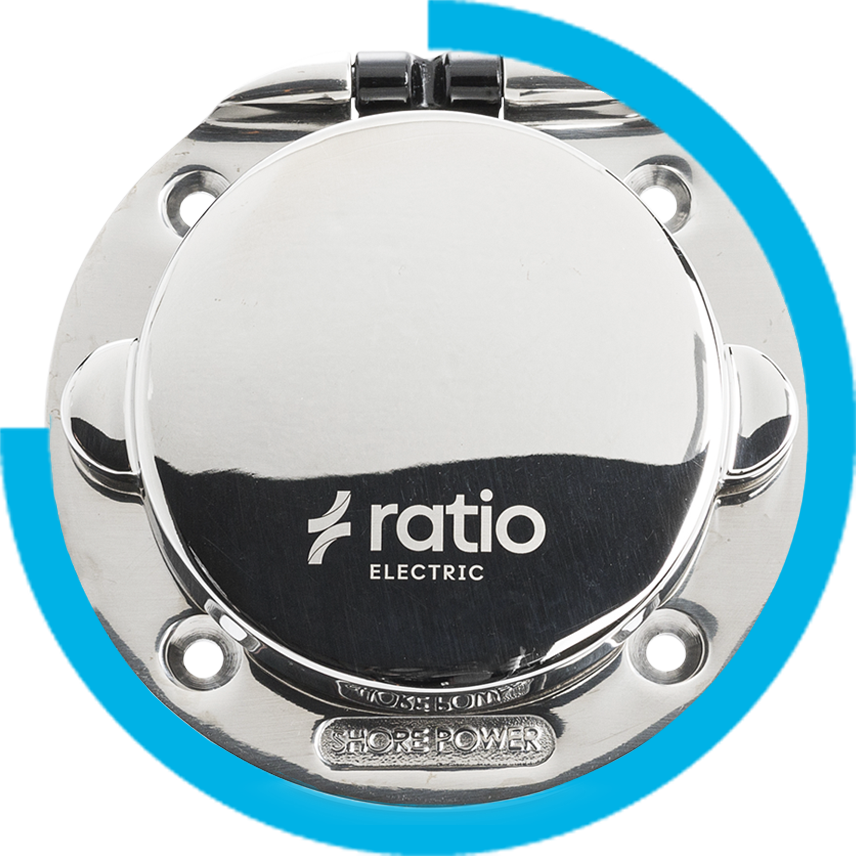
Wide choice in shore power products and kits
The heart of the unique Ratio shore power system is formed by:
- the shore power plug that brings the power from shore
- the shore power inlet that receives the power on the boat
For on the shore side, Ratio also offers the shore power cable that runs from the shore charger to the boat. On the boat side there is a choice of shore power outlets and integrated shore power systems for on board. In addition, many shore power accessories make boat charging into a pleasant and safe experience.
Looking for more details? Check our product offering in the Shore Power brochure
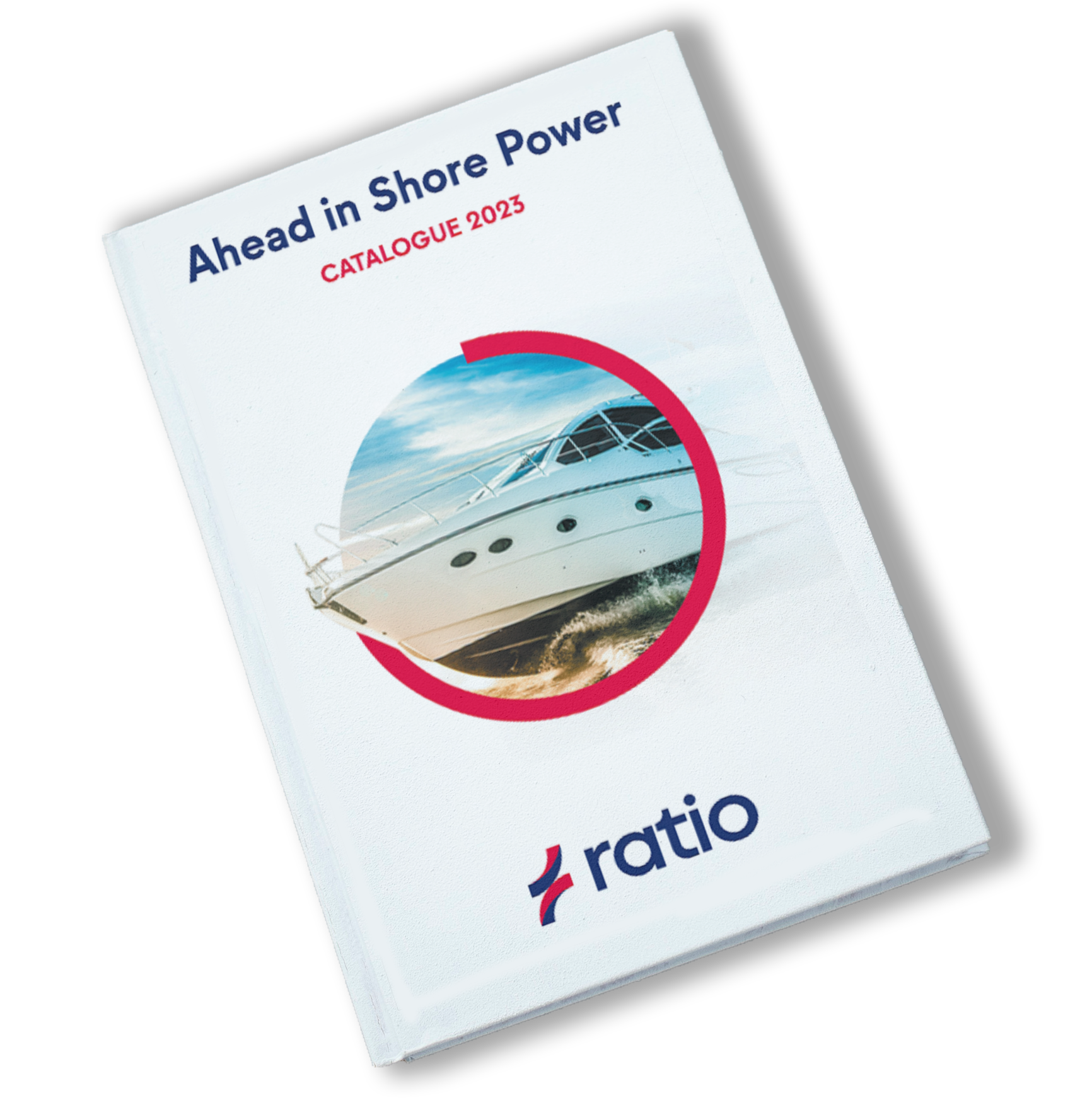
Ahead in Shore Power
Our brochure provides a good overview of our product portfolio in shore power. You can also look up many product details in the online catalog for shore power .
What you also would like to know
 (004).png?v=1707830963)
Discover our new blue Ratio Electric shore power storage bag for stylish and functional storage of your shore power cables during sailing adventures.

As a manufacturer of advanced EV chargers, Ratio has immediately incorporated advanced cybersecurity measures into the development of its Connected EV chargers
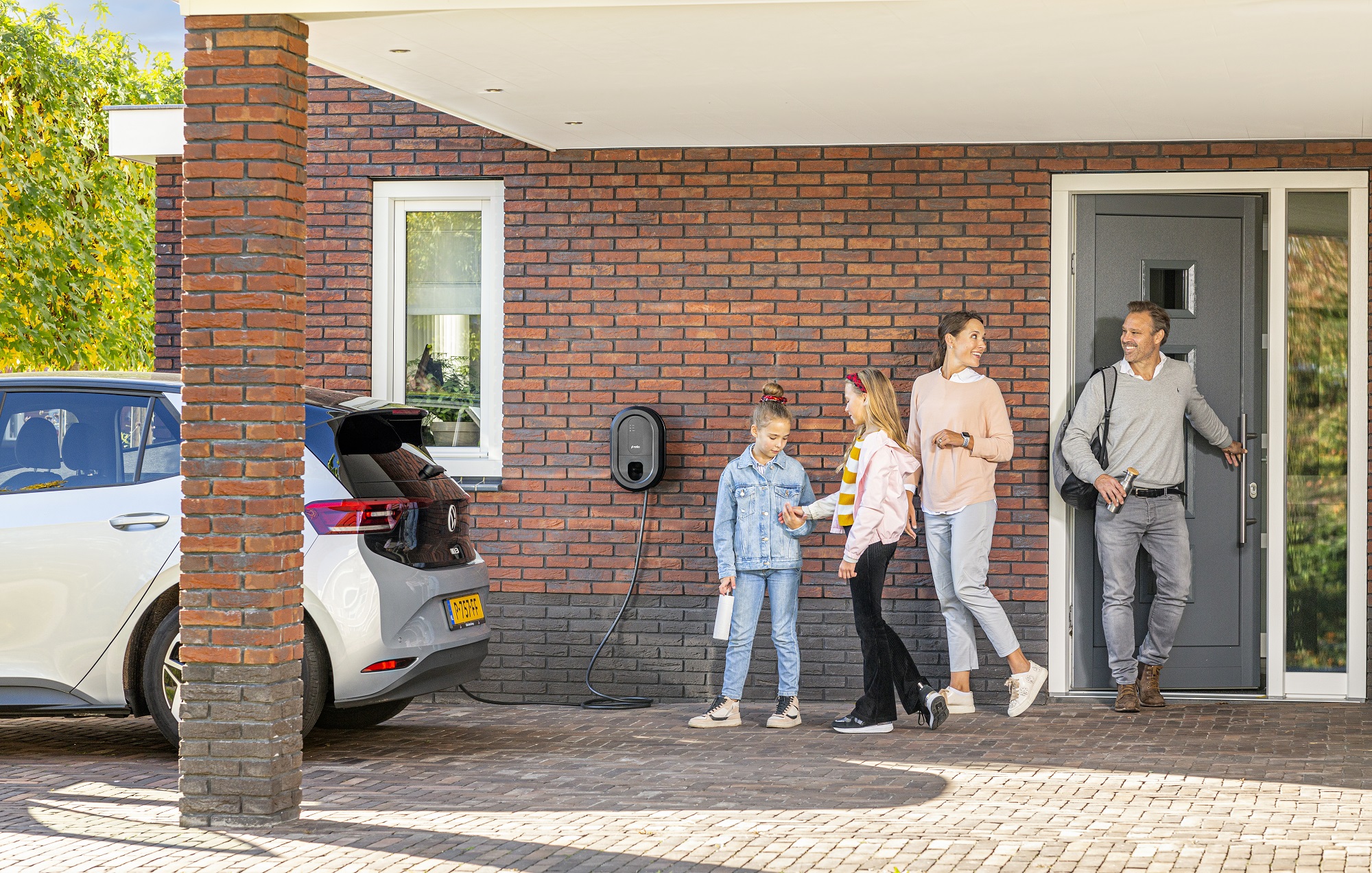
With the Ratio Solar, you charge your electric car via your own solar panels or via the grid
Ratio also develops innovative EV Charging solutions
Want to know more about our smart charging stations with app? Ratio EV chargers, charging cables and mobile car chargers are easy to use, work with any brand of electric car and are reliable.
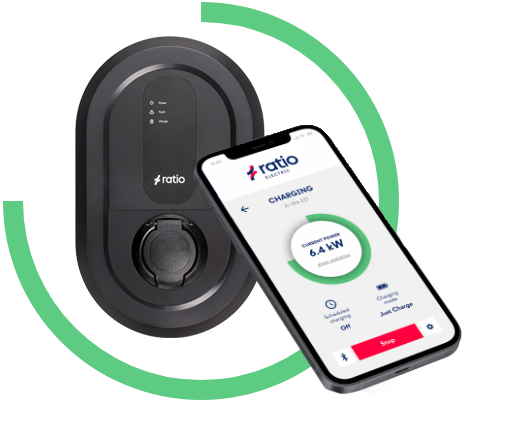
I don't have an account yet
Commentary: Granite Shore Power upholds promise to transition coal power to clean energy
For nearly three quarters of a century, Merrimack Station in Bow and Schiller Station in Portsmouth have reliably served the energy needs of families and businesses across New Hampshire. These facilities keep folks warm on our coldest nights and cool during our hottest days, by burning coal. These two stations, however, have not operated as baseload generation for more than a decade. In fact, in recent years Merrimack Station has been a limited part of New Hampshire’s energy infrastructure.
From our earliest days as owners and operators at Granite Shore Power, we have been crystal clear; we were fully committed to transitioning our facilities away from coal and into a newer, cleaner energy future for the New England region.
And that is precisely what we did last week.
In keeping our promise, Granite Shore Power will voluntarily cease coal-fired operations at Merrimack Station, New England’s last remaining coal-fired power plant, as well as Schiller Station. The historic agreement with the U.S. Environmental Protection Agency (EPA) paves the way for first-of-their-kind “renewable energy parks” in the state of New Hampshire.
That’s right. Coal is being replaced by solar power, clean hydrogen, green biofuels, and battery storage.
Our facilities are ideally situated near the infrastructure necessary to transition the region to the next generation of energy resources. The transformation of these power plants into new, clean energy facilities will facilitate exciting new economic growth at each location.
Just like we have promised for the past six years.
The New Hampshire Seacoast is an area of high-energy demand. By repowering Schiller Station to a battery storage system, we will provide carbon neutral power to reliably support the peak energy demands of New Hampshire every single day. Importantly, this will also provide storage for the wind power being built off the coast of Martha’s Vineyard and in the Gulf of Maine. Our change will make wind power a reality in New Hampshire.
Merrimack Station will continue to be a vital resource when energy demands are at their highest. We will redevelop nearly 400 acres of land into a clean energy center for generations to come.
The continued shift toward a more electrified economy in New England makes developing reliable, affordable on-demand generation resources more important than ever. The Inflation Reduction Act has been key to spurring transition projects like these. New Hampshire will now be at the forefront of building a clean energy economy with the continued support of federal, state, and local leaders.
We believe we’re living up to the good, bipartisan work of these thoughtful leaders with our work. And, with the continued support of state, federal and local officials in the months and years to come, the redevelopment of both Merrimack and Schiller will succeed, and we will better utilize the interconnection at these facilities while advancingthe region’s overall generation mix.
This voluntary agreement by our company is a significant accomplishment in driving clean energy forward. It took the rejection of rhetoric, a focus on facts and a commitment to shared objectives for this energy transition. We are proud of the role we have played in providing a safe and reliable energy bridge and are excited for this next chapter of clean energy infrastructure.
Jim Andrews is chief executive officer of Granite Shore Power.

IMAGES
VIDEO
COMMENTS
Your boat's DC system most likely operates on either 12V or 24V, from energy stored in the boat's batteries which are replenished by the boat's charging system. A second electrical system, your shore power system, allows you to bring AC electricity onboard from a source on the dock. You literally plug your boat into the local utility and ...
There are a few things to keep in mind when using shore power: - Make sure the shore power cord is the correct size and type for your boat. - Inspect the shore power cord for any damage before using it. - Connect the shore power cord to the shore power outlet on the boat. - Once the shore power cord is connected, turn on the shore power ...
For any additional temporary power or shore power questions, please contact our portable power experts today at (954)-644-3876 or send us an email at [email protected]. Marine vessels are often in need of an electrical power source to deliver a safe supply of power to all their tools and accessories on board - while docked at a port ...
Inside the boat, the current carrying capacity of the cable running between the shore power inlet socket and the consumer unit (CU) must be as high, or higher than the maximum supply current, and no more than 3m long. Although most UK pontoon outlets are limited to 16A, it's advisable to install a 30A, 3-core cable to the CU.
If you are wiring a single circuit with outlets rated at 15 amps, the main breaker must be a 15-amp breaker. If you are wiring two circuits and both of them have 15-amp components, each of the branch breakers must be rated for 15 amps; the main breaker can be up to 30 amps. 1) The shore power inlet should be within 10 feet of the panel.
Inspect dockside power receptacles for damage before you plug in. If the cord end falls into the water, wash it with freshwater, dry it and then spray it with a water-dispersing spray such as CRC 6-56. Spray corrosion-blocking spray into the blade sockets every time you plug into a new power post. At the boat:
One additional shore-power consideration on this boat is the 1,000-watt DC-to-AC inverter that has been installed. This was possibly done to facilitate running a laptop at some point, or maybe an electric shaver or small hair dryer. It is located in the aft head compartment, so I'm going with the shaver idea.
1. On Board Wiring. The most practical arrangement has just two power circuits. The first distributes power to a number of conventional 13 amp sockets and is 'fused' by a 16 amp Miniature Circuit Breaker (MCB). The second provides a feed to a battery charger/shore power unit and is 'fused' by a 6 amp MCB.
Many larger boats now come with 50 amp shore power systems, and many marinas now offer 50 amp service. 50 amp cordsets, which are rated either at 50A 125 V or 50A 125/250 V, deliver far more amperage than a 30 amp cord. ...
You recharge them by connecting to shore power or using other means like solar or wind chargers on your sailboat. Benefits of Using a Lithium Battery on a Sailboat While most sailboats still rely on traditional lead-acid batteries, a growing number are sailing into the future by upgrading to lithium batteries for their sailboat house batteries.
Run the shore power cord through the bow pulpit. With the crew member on the dock feeding out the cord to the sailor on deck, walk the shore power cord to the back of the boat. Wrap the cord once or twice around the stern pulpit or lifeline, then connect the female end of the cord to the boat's shore power receptacle.
Chrysler 26 Pymatuning Lake. Feb 17, 2022. #1. Installing shore power. I am going to have two recepticals, one is for the galley and the other is under the galley for a battery charger. I have 30 amp breaker panel with two distribution breakers. I am making sure a ground goes to my lightening rod ground. and also installed a galvanic isolator.
Shore power refers to the systems and components-ashore and on board-that provide alternating current (AC) electricity to a boat. This system generally consists of an onboard inlet and an AC breaker panel to protect circuits and distribute electricity to various electronic accessories. Though it is more technical, the setup is similar to ...
From the dock to the boat, multiple steps must be completed to connect your vessel to shore power. Find Your Boat: https://bit.ly/3tnbSPbFind Your Yacht: htt...
Basic inspections of your AC shore power system are easily accomplished and are well within the ability of any boater. The first step is securing all AC power to avoid accidental shock hazards. Turn off your boats main AC breaker, then the shore pedestal breaker. Next unplug the shore power cord and verify that all other sources of power (such ...
This article describes how to install a 30 Amp shore power system on a small boat. A 30 Amp 120 volt service gives enough power for battery charging, a receptacle or two, and a water heater, or maybe even a small air conditioner. Larger boats with multiple appliances and air conditioners probably would need to look at a 50 amp system.
Shore power, also known as marine shore power, allows you to connect your boat to the electrical grid and enjoy the comforts and conveniences of electricity on board. Whether you need power for your lights, pumps, communications, refrigeration, or any other electrical device, you can find the right shore power plug, shore power outlet, shore ...
A safe AC system requires an onboard dual-pole breaker. The breaker's rating must not exceed the service; i.e., a 30-amp inlet limits the main breaker to 30-amp. However, if the circuit directly supplies outlets in the cabin, the size of the breaker is limited to the outlet ratings — either 15 or 20 amps.
One item I saw related to the bonding or grounding system. These systems serve similar purposes: to carry stray, galvanic or fault current back to its source. Let me clarify two related matters. First, electricity does not "seek ground" as so many dockside sages insist. No, whether from a battery or shore power, it seeks to return to its ...
marine electrical. marine shore power. CONTACT WEST MARINE. Live Chat. 1-800-262-8464. Store Locator. Shop the best selection of Marine Shore Power from West Marine. Visit for products, prices, deals and more!
Europes leading shore power system. Ratio is the authority with solutions for shore power and on-board power. Every product we make is designed to be functional, practical and able to withstand the harsh marine environment. The beautiful designs provide a graceful finish to the boat. Our shore power system is a leading and renowned name in the ...
Commentary: Granite Shore Power upholds promise to transition coal power to clean energy. For nearly three quarters of a century, Merrimack Station in Bow and Schiller Station in Portsmouth have ...